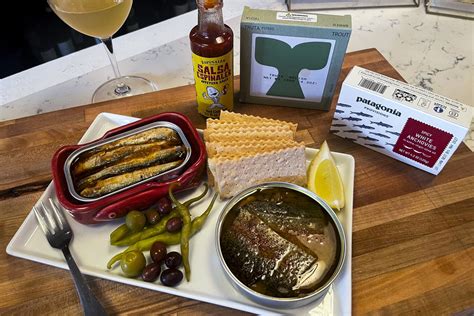
Canned seafood, often relegated to tuna salad, offers a diverse and convenient way to elevate sandwiches beyond the ordinary, providing both nutritional benefits and diverse flavor profiles, according to recent culinary trends highlighted by Yahoo Lifestyle.
Forget the basic tuna sandwich; canned seafood is making a splash as a sophisticated and easy way to upgrade your lunch game. Seafood lovers and culinary adventurers are discovering the versatility of canned fish and shellfish, moving beyond traditional tuna to explore options like sardines, smoked trout, mussels, and even octopus, all readily available and packed with nutrients. This trend is fueled by the convenience, affordability, and sustainability of canned seafood, offering a quick and delicious way to incorporate healthy fats, protein, and essential minerals into everyday meals.
The humble canned fish has shed its reputation as a last resort meal and is now being embraced as a gourmet ingredient, particularly in the realm of sandwich making. Chefs and home cooks alike are finding creative ways to incorporate these pantry staples into exciting and flavorful lunchtime creations. The key is to think beyond the classic mayo-laden tuna salad and explore the diverse flavors and textures that canned seafood has to offer.
“Canned seafood is such an accessible and affordable way to get more seafood into your diet,” says experts quoted in the Yahoo Lifestyle article. It’s not just about taste; it’s also about convenience and nutritional value. Canned seafood is an excellent source of protein, omega-3 fatty acids, and essential vitamins and minerals like vitamin D, vitamin B12, iron, and calcium, all of which contribute to overall health and well-being.
Beyond Tuna: A World of Canned Seafood Sandwich Options
The appeal of canned seafood lies in its versatility. Each type of canned seafood offers a unique flavor profile and texture, making it ideal for a wide range of sandwich combinations.
-
Sardines: These small, oily fish are packed with flavor and nutrients. They can be enjoyed simply with a squeeze of lemon and some crusty bread, or incorporated into more complex sandwiches with ingredients like roasted peppers, olives, and capers. Sardines offer a robust flavor and are a great source of omega-3 fatty acids and calcium.
-
Smoked Trout: Canned smoked trout offers a delicate smoky flavor that pairs well with creamy cheeses, fresh herbs, and crisp vegetables. It can be used in sophisticated sandwiches with ingredients like goat cheese, arugula, and thinly sliced cucumber. The smoky flavor adds depth and complexity to any sandwich.
-
Mussels: Canned mussels offer a briny, slightly sweet flavor that adds a unique twist to sandwiches. They can be combined with ingredients like pickled onions, spicy aioli, and fresh cilantro for a flavorful and satisfying meal. Mussels are also a good source of iron and vitamin B12.
-
Octopus: While perhaps less common, canned octopus offers a firm texture and a mild, slightly sweet flavor. It can be used in Mediterranean-inspired sandwiches with ingredients like hummus, feta cheese, and sun-dried tomatoes. Octopus provides a good source of protein and minerals.
-
Anchovies: Though strong in flavor, a few anchovies can add a salty, umami punch to a sandwich. Try them with roasted red peppers, mozzarella, and a drizzle of olive oil. Their intense flavor complements rich, creamy cheeses and vegetables.
-
Salmon: Canned salmon, a close relative to tuna, offers a milder taste and a richer texture. It pairs well with dill, cream cheese, and cucumber for a light and refreshing sandwich. Its high omega-3 content makes it a nutritional powerhouse.
Tips for Creating the Perfect Canned Seafood Sandwich
To create a truly exceptional canned seafood sandwich, consider the following tips:
-
Choose High-Quality Ingredients: Start with high-quality canned seafood from reputable brands. Look for sustainably sourced options whenever possible. The quality of the canned seafood will significantly impact the overall flavor of the sandwich.
-
Drain Well: Drain the canned seafood thoroughly to prevent the sandwich from becoming soggy. Excess oil or liquid can dilute the flavors and compromise the texture.
-
Don’t Overdo the Mayo: While mayonnaise can be a classic accompaniment to canned seafood, use it sparingly. Too much mayonnaise can overpower the other flavors. Consider using other sauces like aioli, pesto, or vinaigrette for a more complex flavor profile.
-
Add Texture: Incorporate ingredients that add texture to the sandwich, such as crispy vegetables, crunchy nuts, or toasted bread. Texture is just as important as flavor in creating a satisfying sandwich.
-
Balance Flavors: Pay attention to the balance of flavors in your sandwich. Combine salty, sweet, sour, and savory elements for a well-rounded taste experience. Experiment with different combinations to find your favorite flavor profiles.
-
Choose the Right Bread: The bread is an essential component of any sandwich. Choose a bread that complements the flavors of the filling. Crusty bread, sourdough, and whole-wheat bread are all good options. Consider toasting the bread for added texture and flavor.
-
Experiment with Herbs and Spices: Don’t be afraid to experiment with different herbs and spices to enhance the flavor of your canned seafood. Fresh herbs like dill, parsley, and cilantro can add brightness and freshness. Spices like paprika, cumin, and chili powder can add warmth and depth.
-
Consider the Condiments: Condiments can make or break a sandwich. Choose condiments that complement the flavors of the filling. Mustard, relish, hot sauce, and pickles are all popular choices.
-
Think About Presentation: Presentation matters, even for a simple sandwich. Cut the sandwich in half or into triangles for easy eating. Arrange the ingredients neatly and attractively.
Nutritional Benefits of Canned Seafood
Canned seafood is not only delicious and convenient but also packed with essential nutrients. Incorporating canned seafood into your diet can offer a range of health benefits:
-
Protein: Canned seafood is an excellent source of protein, which is essential for building and repairing tissues, supporting immune function, and promoting satiety. Protein helps to keep you feeling full and satisfied, which can aid in weight management.
-
Omega-3 Fatty Acids: Canned seafood, particularly oily fish like sardines and salmon, is rich in omega-3 fatty acids, which are beneficial for heart health, brain function, and reducing inflammation. Omega-3 fatty acids have been linked to a reduced risk of heart disease, stroke, and certain types of cancer.
-
Vitamin D: Canned seafood is a good source of vitamin D, which is essential for bone health, immune function, and mood regulation. Vitamin D helps the body absorb calcium, which is crucial for maintaining strong bones and preventing osteoporosis.
-
Vitamin B12: Canned seafood is an excellent source of vitamin B12, which is essential for nerve function, red blood cell production, and DNA synthesis. Vitamin B12 deficiency can lead to fatigue, weakness, and neurological problems.
-
Iron: Canned seafood is a good source of iron, which is essential for red blood cell production and oxygen transport. Iron deficiency can lead to anemia, which can cause fatigue, weakness, and shortness of breath.
-
Calcium: Canned seafood, particularly sardines with bones, is a good source of calcium, which is essential for bone health, muscle function, and nerve function. Calcium helps to maintain strong bones and prevent osteoporosis.
-
Selenium: Canned seafood is a good source of selenium, an essential trace mineral that acts as an antioxidant, protecting cells from damage. Selenium is important for immune function, thyroid hormone metabolism, and reproduction.
Sustainability of Canned Seafood
With growing concerns about overfishing and environmental sustainability, it’s important to choose canned seafood that is responsibly sourced. Look for certifications like the Marine Stewardship Council (MSC) label, which indicates that the seafood has been caught using sustainable fishing practices.
Many canned seafood brands are committed to sustainable fishing practices and work with organizations to ensure that their products are harvested in an environmentally responsible manner. By choosing sustainably sourced canned seafood, you can enjoy your favorite sandwiches while also supporting healthy oceans and marine ecosystems.
Canned Seafood Around the World
The use of canned seafood in sandwiches and other dishes varies across different cultures. In some countries, canned seafood is a staple ingredient in traditional cuisine, while in others, it is a more recent trend.
-
Spain: In Spain, canned seafood, known as conservas, is a highly prized delicacy. Spanish conservas are often preserved in olive oil and are considered to be of exceptional quality. They are enjoyed as tapas or used in sandwiches and salads.
-
Portugal: Portugal is another country with a strong tradition of canned seafood consumption. Portuguese canned seafood is known for its high quality and variety. It is often enjoyed with bread or crackers as a simple and delicious meal.
-
France: In France, canned sardines and mackerel are popular sandwich fillings. They are often combined with ingredients like Dijon mustard, cornichons, and tomatoes.
-
Italy: In Italy, canned tuna is a common ingredient in sandwiches and salads. It is often combined with ingredients like olives, capers, and sun-dried tomatoes.
-
Japan: In Japan, canned seafood is used in a variety of dishes, including sushi, rice bowls, and salads. Canned salmon and tuna are particularly popular.
Expanding Your Culinary Horizons
The trend of upgrading sandwiches with canned seafood is not just about convenience; it’s also about expanding culinary horizons and discovering new flavors and textures. By experimenting with different types of canned seafood and ingredients, you can create unique and satisfying sandwiches that are both delicious and nutritious.
Canned seafood offers a convenient and affordable way to incorporate healthy fats, protein, and essential minerals into your diet. It’s a versatile ingredient that can be used in a wide range of dishes, from simple sandwiches to sophisticated appetizers. So, the next time you’re looking for a quick and easy meal, reach for a can of seafood and let your culinary creativity shine.
Recipe Ideas
Here are a few recipe ideas to get you started:
-
Sardine and Roasted Pepper Sandwich: Combine canned sardines with roasted red peppers, olives, capers, and a drizzle of olive oil. Serve on crusty bread.
-
Smoked Trout and Goat Cheese Sandwich: Combine canned smoked trout with goat cheese, arugula, thinly sliced cucumber, and a squeeze of lemon juice. Serve on whole-wheat bread.
-
Mussel and Pickled Onion Sandwich: Combine canned mussels with pickled onions, spicy aioli, and fresh cilantro. Serve on a baguette.
-
Octopus and Hummus Sandwich: Combine canned octopus with hummus, feta cheese, sun-dried tomatoes, and a drizzle of olive oil. Serve on pita bread.
-
Spicy Tuna Salad Sandwich: Mix canned tuna with mayonnaise, sriracha, chopped celery, and red onion. Serve on toasted bread.
The Future of Canned Seafood
As consumers become increasingly interested in sustainable and convenient food options, the popularity of canned seafood is likely to continue to grow. With its versatility, affordability, and nutritional benefits, canned seafood is well-positioned to become a staple ingredient in kitchens around the world.
Innovations in canning technology and sustainable fishing practices are also contributing to the growth of the canned seafood industry. As more companies invest in these areas, consumers can expect to see an even wider variety of high-quality, responsibly sourced canned seafood options in the future.
The canned seafood aisle is no longer a place to be feared, but rather a treasure trove of culinary possibilities. So, embrace the trend and start exploring the world of canned seafood. Your taste buds will thank you.
Frequently Asked Questions (FAQ)
-
Is canned seafood healthy?
Yes, canned seafood is generally considered healthy. It’s a good source of protein, omega-3 fatty acids (especially in oily fish like sardines and salmon), vitamin D, vitamin B12, iron, calcium, and selenium. These nutrients contribute to heart health, brain function, bone strength, and overall well-being. However, be mindful of sodium content, as some canned seafood may be high in salt. Look for low-sodium options when available.
-
Is canned seafood sustainable?
Sustainability varies depending on the species and fishing methods used. To ensure you’re making a sustainable choice, look for certifications like the Marine Stewardship Council (MSC) label. This indicates that the seafood has been caught using sustainable fishing practices that minimize environmental impact. Researching the brand and their sourcing practices can also help you make an informed decision.
-
How long does canned seafood last?
Canned seafood has a long shelf life. Unopened cans typically last for several years when stored in a cool, dry place. Check the “best by” or “expiration” date on the can for specific guidance. Once opened, canned seafood should be refrigerated and consumed within 1-2 days to maintain freshness and prevent spoilage.
-
What is the best way to drain canned seafood?
To drain canned seafood effectively, use a fine-mesh sieve or colander. Press gently on the seafood with a spoon or fork to remove excess liquid. For oil-packed seafood, you can also gently blot it with a paper towel to remove excess oil. Proper draining helps prevent your sandwich from becoming soggy.
-
Can I eat the bones in canned sardines?
Yes, you can eat the bones in canned sardines. In fact, the bones are a good source of calcium. They are typically soft enough to eat without any problems. The canning process softens the bones, making them easily digestible. If you are concerned about the texture, you can remove the bones, but you will be missing out on a significant source of calcium.
-
What are the best types of bread to use for canned seafood sandwiches?
The best type of bread depends on the specific canned seafood you are using and your personal preference. Crusty breads like baguette or sourdough work well with robust flavors like sardines or smoked trout. Softer breads like whole wheat or brioche are good choices for milder fillings like tuna or salmon. Toasting the bread can add extra texture and prevent the sandwich from becoming soggy.
-
What are some good alternatives to mayonnaise for canned seafood sandwiches?
If you’re looking to reduce the amount of mayonnaise in your canned seafood sandwich, there are many delicious alternatives. Aioli (garlic mayonnaise), pesto, hummus, Greek yogurt, avocado, and vinaigrettes are all excellent options. These alternatives can add flavor, creaminess, and nutritional value to your sandwich.
-
How can I add more flavor to my canned seafood sandwiches?
There are many ways to add more flavor to your canned seafood sandwiches. Consider adding fresh herbs like dill, parsley, or cilantro. Spices like paprika, cumin, or chili powder can add warmth and depth. Pickled onions, capers, olives, sun-dried tomatoes, and roasted vegetables can also add complexity and interest. Don’t be afraid to experiment with different combinations to find your favorite flavor profiles.
-
Is canned seafood safe to eat during pregnancy?
Canned seafood can be a healthy part of a pregnancy diet, but it’s important to choose wisely. Limit consumption of canned white (albacore) tuna due to its higher mercury content. Lighter tuna (skipjack) is generally considered safe in moderation. Other canned seafood options like sardines and salmon are also safe and nutritious choices. Always consult with your healthcare provider for personalized dietary recommendations during pregnancy.
-
How can I make my canned seafood sandwiches more visually appealing?
Presentation matters, even for a simple sandwich. Arrange the ingredients neatly and attractively. Cut the sandwich in half or into triangles for easy eating. Garnish with fresh herbs or a sprig of parsley. Use colorful ingredients like roasted red peppers or sliced tomatoes to add visual appeal. Consider toasting the bread for a more polished look.









